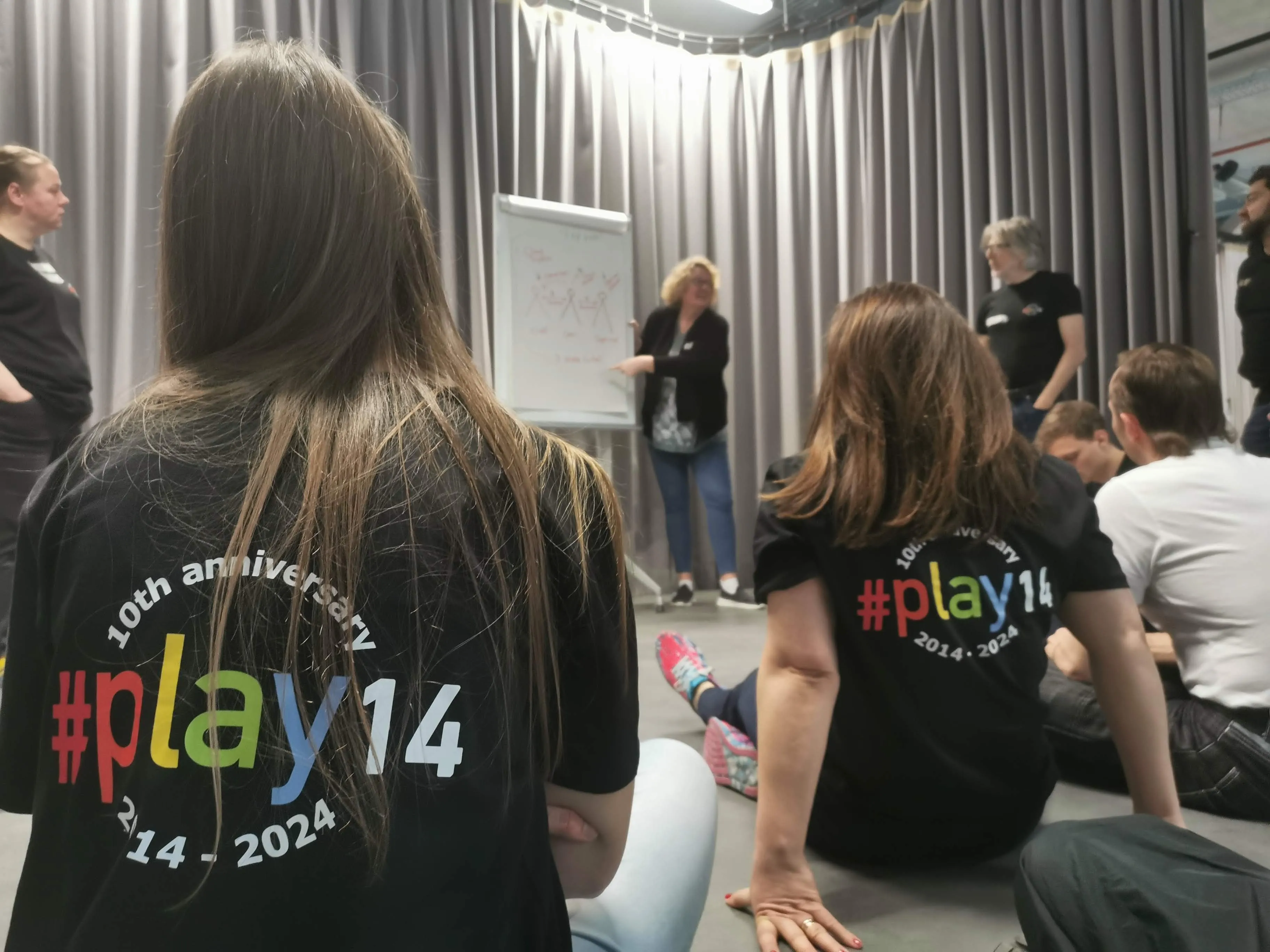
5 Serious Games To Better Know Each Other


Facilitators at Marmelab always look for new tools to help team members collaborate efficiently.
We recently attended #play14 in Luxembourg, the international event for serious games that brings together people who believe that games are a great way to improve collaboration skills. Participants at the event explore various serious games, each providing unique insights.
In this second article, we focus on remote games, energizers, and personality-revealing activities we discovered. If you missed our first article, catch up here.
Games for remote teams

Maintaining cohesion among remote workers can pose a challenge, necessitating a continuous exploration of innovative methods to engage and foster connections among them. There are numerous remote team-building activities that can be implemented, as highlighted during this dedicated workshop:
- Roller Coaster: Participants mime a roller coaster ride, engaging in energetic and imaginative gestures.
- Tower Building: Using objects available to them, participants construct the tallest tower in front of their cameras, encouraging creativity and improvisation.
- Online Museum Tour: Organize a virtual tour of a museum, providing links (a lot of links here) to various exhibits for participants to explore together.
- Photo Booth: Participants select a theme (e.g., building a beard, becoming a superhero, holiday-themed) and a time limit. Each individual turns off their camera to prepare their creative interpretation, then reveals their creation once the time is up.
- Soundscape: For participants without access to cameras, recreate a specific auditory environment (e.g., a forest, Times Square). Each participant contributes sound effects to collectively build the soundscape.
- Silly Yoga: Each participant suggests a yoga pose that can be performed in front of the camera. Everyone attempts to execute the poses suggested, ensuring some laughter.
These fun games help alleviate the feeling of isolation that remote collaborators may experience. It’s hard to recreate the spontaneity of in-person meetings, but serious games like these are effective icebreakers.
Numerous other activities can be explored or devised, but the paramount consideration is the recognition that tools exist to facilitate remote team building effectively.
During this workshop, we particularly noticed the dedication of the facilitator, who expends even more effort than in face-to-face interactions to ensure that all participants are actively engaged in the activities.
Tolerance and Acceptance guide

This workshop focused on using a grid as a metric for evaluating the acceptability of various scenarios. The grid includes 8 levels of acceptance, with higher values indicating lower levels of acceptability. It serves as a tool for establishing implicit guidelines within a team regarding what is deemed acceptable and what is not.
The facilitator introduces several scenarios (e.g., ‘a participant arrives more than 20 minutes late to a meeting without prior notice’). Following the presentation of each scenario, participants are given time to indicate their level of acceptance for the situation, similar to planning poker.
This tool is meant to be used before the start of a collaboration between people who don’t know each other. It helps to create an implicit behavior charter. It’s interesting to discover that the same situation can be perceived differently within the same team, which could potentially become a source of contention.
“Drawings Speak” Game: Revealing Personalities
To kick off the workshop, the facilitator distributed paper and felt pens to each participant and instructed us to draw a tree. To avoid influencing each other, we were divided into separate areas. Next, the facilitator collected the drawings, shuffled them and displayed them on the table. Then, we formed groups of 2 or 3 persons.
The aim was to find out which person had drawn which picture by asking questions to each member of the group.
In our group of three, we asked dozens of questions to identify each person’s drawing. The questions that proved most helpful were:
Member 1: How do you shop? By following a list written in advance
Member 2: Do you prefer black or colors? Colors
Member 3: Do you like to draw? Yes Do you like animals, particularly owls? Yes

Can you find the correct drawings?
I found this workshop highly enjoyable as it introduced an innovative technique for uncovering the personalities and interests of others. It works exceptionally well in groups where participants know little or nothing about each other.
Expressing Ideas Brick by Brick
In this workshop, the aim was to stage our personal interpretation of a successful event. How could we represent it with Lego bricks? We proceeded step by step.
First step: build a tower in 3 minutes Seems simple, right? But after 3 minutes, I noticed that each tower was unique: some were big, others colorful… The facilitator prompted us to explain the reasoning behind our brick selection and the construction of our tower.
Second step: choose 8 Lego bricks With no further instructions, we began. However, once we had selected our 8 Lego bricks, the facilitator instructed us to pass them to our left neighbor. The first challenge arose: I found myself with Lego bricks that I hadn’t chosen.
Next, each of us selected a post-it note containing an idea such as « To Celebrate », « Toilet » or « Disconnect ». A few minutes at hand, we set about imagining how to convey the idea using our Lego bricks.

While not every idea was easy to represent, all the constructions were remarkably explicit. It was impressive to see how one could convey ideas using just a few Lego bricks.
Third step: what defines a successful event for us? After completing the first two steps, we were equipped to answer this question. In groups of five, we designed what we considered the ideal event.
Our group envisioned a big party filled with exciting elements such as a swimming pool, a slide, and lively music. We then decided to tell a story that illustrated the transformation of our state of mind before and after the event.
At the start of our story, our character is in a monotonous routine. However, an invitation to a party changes everything. They attend the event, where they mingle with diverse individuals and truly have a blast. As they leave the party, our character has grown up, in every sense of the word.
To conclude, this workshop demonstrated the ability to convey ideas using common objects like Lego bricks. Research has shown that thinking relies on our limited short-term memory. Using Lego bricks helps to solidify ideas as reflections develop. Initially, our aim was to create a fun event, but as the workshop progressed, we realized we could go further and build a narrative around it.

Powerpoint Karaoke
No, this is not your typical karaoke setup. This game is more about honing your improvisational skills while having fun.

It begins as an improv show, where one person selects a theme and challenges another to improvise on it. The real fun kicks in when different slides appear, each containing random graphics or images. The challenge lies in delivering a presentation on the chosen theme while incorporating these unexpected visuals as support. The contrast between the subject and the absurd images guarantees some chuckles, all while keeping you on your feet.
This tool is quite versatile as it can be used either as an energizer or a team-building activity. Beyond the fun it generates, it is fascinating to see how participants evolve during the exercise. I find the variant with multiple participants particularly interesting, as it allows for the observation of their camaraderie and their ability to support each other in case of difficulty.
You can learn more about this exercise here:
Conclusion
Even though the event proved physically exhausting, we left brimming with fresh gaming concepts. It’s remarkable how diverse individuals seamlessly unite for #play14, driven by a shared passion for experimentation and meaningful interactions. Each attendee adds a unique perspective, contributing to the event’s vibrant atmosphere of camaraderie and human connection.
Authors

Facilitator at Marmelab, she lives with two rabbits and loves playing boards games.

Facilitator at Marmelab, Benoît is a family guy, so he can't spend as much time as he'd like on his other passions - sport and music.